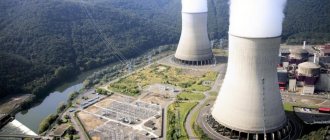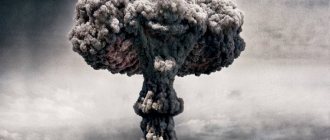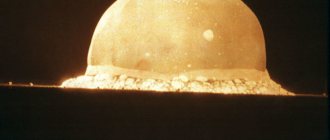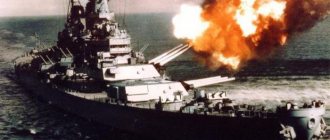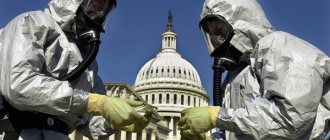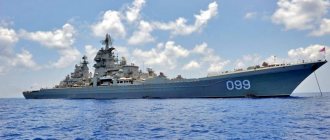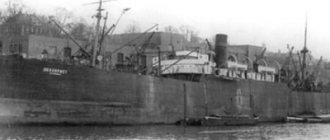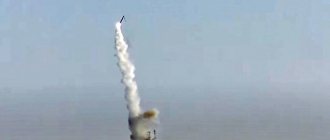All contemporaries have long known about the terrifying arms race organized by the Americans and the Soviet Union after the end of World War II. And the main object in this action was space, which was not used for good and peaceful purposes.
Thus, by the end of the fifties of the last century, all the world's media trumpeted not only about satellite launches, but about nuclear explosions that took place in outer space closest to the Earth. Of course, the Union was also aware of such experiments, but no one in the world knew about the Soviet tests. The Iron Curtain blocked access to secret information about the USSR's nuclear experiments. However, it has not been disclosed to this day, and all existing stories about Soviet military space operations are unofficial information.
Of course, both the USSR and the USA were collecting data on how a nuclear explosion and the radiation “hatching” from it, like a chicken from an egg, affects the operating condition of satellite equipment, rockets and systems connecting the Earth with “space”. This bacchanalia ended only in 1963, thanks to the signing of an agreement between three countries, including Great Britain. This document banned all further tests of nuclear weapons both in space and in the earth’s atmosphere, as well as under water.
American experiments
The nuclear explosion in space, carried out by the Americans, by the way, more than once or twice, on the one hand, was of a scientific nature, on the other hand, it destroyed everything. After all, no one knew how the background radiation would behave after the explosion. Scientists could only speculate, but no one expected such shocking material that they eventually received. Below we will talk about the impact of a nuclear explosion in space on ordinary earthly life and their inhabitants.
The first and most famous was Operation Argus, carried out one September day in 1958. Moreover, the area for preparing the explosion of a nuclear bomb in space was selected very carefully.
The Sun and Moon are the only cosmic bodies that can be seen during the day
What astronomical object can we see in the sky during the day? That's right, Sun. Many people have seen the Moon more than once during the day. Most often it is visible either in the early morning or when it is just beginning to get dark. However, most people believe that only these space objects can be seen in the sky during the day. Fearing for their health, people usually do not look at the Sun. But next to it during the day you can find something else.
There is another object in the sky that can be seen in the sky even during the day. This object is Venus. When you look into the night sky and see a clearly visible point of light on it, know that most often you are seeing Venus, and not some star. Phil Plait, Bad Astronomy columnist for the Discover portal, has compiled a small guide, following which you can find both Venus and the Moon in the daytime sky. The author advises to be very careful and try not to look at the Sun.
Details of Operation Argus
So, in the early autumn of 1958, the South Atlantic turned into a real testing ground. The operation involved testing a nuclear explosion in space within the Van Allen radiation belts. The stated goal was to clarify all the consequences for communications, as well as the electronic content of satellite “bodies” and ballistic missiles.
The secondary goal was no less interesting: scientists needed to confirm or refute the fact of the formation of an artificial radiation belt within our planet through a nuclear explosion in space. Therefore, the Americans chose a very predictable place, in which there is a special anomaly: it is in the south of the Atlantic region that the radiation belts come closest to the earth’s surface.
For such a global operation, the American leadership created a special unit from the country’s second fleet, calling it number 88. It consisted of nine ships with more than four thousand employees. Such a quantity was necessary due to the scale of the project itself, because after a nuclear explosion in space, the Americans needed to collect the data obtained. For these purposes, the ships carried special rockets designed for geodetic launches.
During the same period, the Explorer-4 satellite was launched into outer space. Its task was to isolate data on the background radiation in the Van Allen Belt from general space information. There was also his brother, Explorer 5, whose launch failed.
How did the test of a nuclear bomb explode in space take place? The first launch took place on August 27. The rocket was delivered to an altitude of 161 km. The second was on August 30, when the rocket rose to 292 km, but the third, carried out on September 6, went down in history as the highest and largest nuclear explosion in space. The September launch was marked by an altitude of 467 km.
The power of the explosion was determined to be 1.7 kilotons, and one warhead weighed almost 99 kg. To find out what would happen from a nuclear explosion in space, the Americans sent warheads using a previously modified X-17A ballistic missile. It had a length of 13 m and a diameter of 2 m.
As a result, after collecting all the research data, Operation Argus proved that due to the electromagnetic pulse received as a result of the explosion, equipment and communications can not only be damaged, but also completely fail. True, in addition to this information, sensational news was revealed confirming the emergence of artificial radiation belts on our planet. An American newspaper, using a photo of a nuclear explosion from space, described Argus as the largest-scale scientific experiment in the entire history of modern mankind.
And that same connection 88, which found itself in the immediate thick of events, was disbanded and, according to reliable sources, there were more people who died from cancer among them than in the groups involved in monitoring and recording data.
The influence of the Moon on the ebb and flow of tides
One of the most common misconceptions relates to how tidal forces work. Most people understand that these forces depend on the Moon. And it is true. However, many people still mistakenly believe that only the Moon is responsible for these processes. In simple terms, tidal forces can be controlled by the gravitational forces of any nearby cosmic body of sufficient size. And although the Moon does have a large mass and is located close to us, it is not the only source of this phenomenon. The Sun also has a certain influence on tidal forces. At the same time, the joint influence of the Moon and the Sun increases many times over at the moment of alignment (in one line) of these two astronomical objects.
However, the Moon does have more influence on these earthly processes than the Sun. This is because even despite the colossal difference in mass, the Moon is closer to us. If one day the Moon is destroyed, the disturbance of the ocean waters will not stop at all. However, the behavior of the tides itself will definitely change significantly.
Soviet secret operations
The Soviet Union was also interested in the damaging effects of a nuclear explosion in space, therefore, according to unconfirmed reports, a whole series of experiments was carried out under the code name “Operation K”. The tests were carried out after the American ones. Soviet scientists conducted experiments to determine whether a nuclear explosion is possible in space at a missile test site located in the settlement of Kapustin Yar.
A total of five tests were carried out. The first two were in 1961, in the fall, and a year later, almost at the same time, the remaining three. All of them are about with the ordinal number of the launch. In order to understand what a nuclear explosion looks like from space, two ballistic missiles were launched. One was equipped with a charge, and the other had special sensors that monitored the process.
During the first two operations, the charges reached 300 and 150 km, respectively, and the other three had similar data, except for “K-5” - it exploded at an altitude of 80 km. According to tester Boris Chertok, who wrote the book “Rockets and People,” the flash from the explosion glowed for only a small fraction of a second; it looked like a second sun. The USSR found out the same information as the Americans - all radio devices worked with noticeable disturbances, and radio communications were generally interrupted for some time within the radius of the nearest area.
Explosions in space
But in addition to the above tests, in the interval between the American and Soviet operations, the United States managed to carry out two more nuclear explosions in space, the consequences of which were much more tragic.
One of the launches, made in 1962, was called “Fishball”, but was known among the military as “Starfish”. The explosion was supposed to occur at an altitude of 400 kilometers, and its power was supposed to be 1.4 megatons. However, this operation was unsuccessful. On June 20, 1962, a ballistic missile with a technical malfunction, which was not known, was sent from a missile test site located on the Pacific Johnston Atoll. Thus, 59 seconds after launch, its engine simply turned off.
Then, to prevent a global catastrophe, the security officer gave the command to the missile to self-destruct. The missile was detonated at an altitude of just 11 km, which is the cruising altitude for many civil aircraft. In the end, fortunately for the Americans, the explosive destroyed the missile, which made it possible to protect the islands from a nuclear explosion. True, some of the debris that fell on the nearby Sand Atoll was able to contaminate the area with radiation.
On July 9, they decided to repeat the experiment. But this time the launch was successful and, judging by the photographs taken of a nuclear explosion in space, the red glow was visible even from New Zealand, located 7,000 km from Johnson. This test was quickly made public, unlike the first experimental experiments.
USSR and US spacecraft observed the successful launch. The Union, thanks to the Cosmos-5 satellite, was able to record an increase in gamma radiation by a decent number of orders of magnitude. But the satellite was floating in outer space 1,200 m below the explosion. Afterwards, the appearance of a powerful radiation belt was noted, and three satellites that passed through its “body” practically failed due to damage to solar panels. Therefore, in 1962, the USSR checked the coordinates of the location of this belt when launching the Vostok-3 and Vostok-4 missiles. Nuclear contamination of the magnetosphere was noted over the next few years.
The next American launch took place on October 20 of the same year. His code name was "Chickmate". The warhead exploded at an altitude of 147 km, and the test site was outer space itself.
Tactical and technical data of the most powerful aerial bombs
| Air bomb | GBU-43/B | (AVBPM) |
| Affiliation | USA | Russia |
| A year of testing | 2003 | 2007 |
| Length, m | 10 | n.d. |
| Diameter, m | 1 | n.d. |
| Mass, t – total – explosive | 9,5 8,4 | 7 n.d. |
| TNT equivalent, t | 11 | 44 |
| Radius of guaranteed destruction, m | 140 | 400 |
The table shows a fourfold superiority in power with a quarter less total weight.
Obviously, this could be achieved through the use of thermobaric explosives.
How does a nuclear explosion occur in space?
We got acquainted with all the tests, fortunately no other country in the world supported such Soviet-American experiments. Now let's look at what a nuclear explosion looks like from space, according to a scientific explanation. What sequence of events occurs after a nuclear warhead is delivered into outer space?
During the first tens of nanoseconds, gamma rays are ejected from it at high speed. At an altitude of 30 km in the earth's atmosphere, gamma rays collide with neutral molecules and subsequently form electrons endowed with high energy. Developing enormous speed, already charged particles give rise to powerful electromagnetic radiation, which disables absolutely any sensitive electronic devices located in the radiation zone on the ground.
For the next couple of seconds, the released energy from the warhead will act as x-ray radiation. True, such an X-ray consists of very powerful waves and electromagnetic flows. It is they who create voltage inside the satellite, which is why all its electronic filling simply burns out.
The temperature of the sun is constantly rising
One of the most popular conspiracy theories is that the Earth's exposure to sunlight is increasing. However, this is not due to environmental pollution and any global climate changes, but due to the fact that the temperature of the Sun is rising. This statement is partially true. However, this increase depends on what year it is on the calendar.
Since 1843, scientists have continually documented solar cycles. Thanks to this observation, they realized that our Sun is quite predictable. During a certain cycle of its activity, the temperature of the Sun rises to a certain limit. The cycle changes and the temperature begins to decrease. According to NASA scientists, each solar cycle lasts about 11 years, and researchers have been tracking each of them for the last 150.
Although many things about our climate and its relationship to solar activity still remain a mystery to scientists, science has a pretty good idea of when we can expect solar activity to increase or decrease. The periods of heating and cooling of the Sun are usually called solar maximum and solar minimum. When the Sun is at its maximum, the entire solar system becomes warmer. However, this process is completely natural and occurs every 11 years.
What happens to weapons in space after an explosion?
But the explosion does not end there; its final part appears in the form of scattered ionized remains of the warhead. They travel hundreds of kilometers until they interact with the earth's magnetic field. After such contact, a low-frequency electric field is created, the waves of which gradually spread around the entire planet and are reflected from the lower edges of the ionosphere, as well as from the earth's surface.
But even low frequencies can have devastating consequences for electrical circuits and lines located underwater far from the explosion site. Over the following months, electrons caught in the magnetic field gradually render all electronics and avionics of earthly satellites out of working order.
US missile defense system
Thanks to the presence of photos from space with a nuclear explosion and all the accompanying information on the study of launches, America began to form a missile defense complex. However, creating something that can resist long-range missiles is quite difficult and, rather, impossible. That is, if you use a missile defense missile against an incoming missile with a nuclear warhead, you will get a real high-altitude nuclear explosion.
At the beginning of the 21st century, experts from the Pentagon carried out assessment work related to the consequences of nuclear space tests. According to their report, even a small nuclear charge, for example, equal to 20 kilotons (the bomb in Hiroshima had exactly this figure) and detonated at an altitude of up to 300 km, in just a couple of weeks will disable absolutely all satellite systems that are not protected from background radiation. Thus, for about a month, countries that have satellite “bodies” in low orbit will be left without their help.
Dark side of the Moon
Many people have probably heard the album “The Dark Side of the Moon” by Pink Floyd, and the idea that the Moon has a dark side has become very popular among society. The only thing is that the Moon does not have any dark side. This expression is one of the most common misconceptions. And its reason is connected with the way the Moon revolves around the Earth, and also with the fact that the Moon is always turned to our planet with only one side. However, despite the fact that we see only one side of it, we often witness that some parts of it become lighter, while others are covered in darkness. Given this, it was logical to assume that the same rule would be true for the other side.
A more accurate description would be "the far side of the Moon." And even if we don't see it, it doesn't always remain dark. The thing is that the source of the Moon’s glow in the sky is not the Earth, but the Sun. Even if we cannot see the other side of the Moon, it is also illuminated by the Sun. This happens cyclically, just like on Earth. True, this cycle lasts a little longer. A full lunar day is equivalent to about two Earth weeks. Two interesting facts to follow. Lunar space programs have never landed on the side of the Moon that always faces away from Earth. Manned space missions have never been carried out during the night lunar cycle.
Consequences
According to the same Pentagon report, due to a high-altitude nuclear explosion, many points in near-Earth space absorb radiation increased by several orders of magnitude and maintain this level over the next two to three years. Despite the initial anti-radiation protection assumed in the design of the satellite system, the accumulation of radiation occurs much faster than expected.
In this case, the orientation instruments and communications will initially stop working. It follows that the lifespan of the satellite will be reduced significantly. Plus, the increased background radiation will make it impossible to send a team to carry out repair work. The standby mode will last for a year or more until the radiation level decreases. If a nuclear warhead is re-launched into space, replacing all the devices will cost one hundred billion dollars, and this does not take into account the damage caused to the economic sphere.
Thermobaric ammunition
Along with BOV, thermobaric ammunition (TBM) is widely known. With the same effect of oxidation of explosives in the air, the principle of operation of such ammunition differs from BOV.
Due to the detonation of the central explosive charge, the thermobaric mixture detonates. The resulting blast wave ensures rapid mixing with air and combustion of the thermobaric composition. TBB uses a mixture based on nitroesters and aluminum powder.
The solid version of the mixture is A-3 (65% hexogen, 5% wax and 30% aluminum powder).
Advantages of TBB over volumetric detonating:
- no restrictions on the mass of explosives. This made it possible to create fire weapons to arm individual military personnel;
- insensitivity to atmospheric phenomena.
Several types of weapons have been developed under the TBB. The most common ones are:
- heavy flamethrower system "Buratino";
- rocket infantry flamethrower "Bumblebee";
- shots for RPG-7;
- grenades for an underbarrel grenade launcher.
At the same time, work continues on the creation of high-power thermobaric ammunition.
What protection can there be from radiation?
For many years, the Pentagon has been trying to develop the right program to create protection for its satellite devices. Most military satellites have been moved to higher orbits, which are considered the safest in terms of radiation released during a nuclear explosion. Some satellites are equipped with special shields that can protect electronic devices from radiation waves. In general, this is something like Faraday cages: peculiar metal shells that do not have access from the outside, and also do not allow the external electromagnetic field to enter. The shell is made of aluminum up to one centimeter thick.
But the head of the project being developed at the US Air Force laboratories, Greg Ginet, argues that if now American spacecraft are not completely protected from radiation, then in the future it will be possible to eliminate it much faster than nature itself can handle it. A group of scientists are examining the step-by-step possibility of blowing out background radiation from low orbits thanks to the artificial creation of low-frequency radio waves.
What is HAARP
If we consider the above point in theoretical terms, then it is possible to create entire flotillas of special satellites, whose job would be to produce these very low-frequency radio waves close to the radiation belts. The project is called HAARP or the High Frequency Active Auroral Region Research Program. The work is being carried out in Alaska in the settlement of Gakona.
Here they study active sites that arise in the ionosphere. Scientists are trying to achieve results in controlling their properties. In addition to outer space, this project is also aimed at researching the latest communication technologies with submarines, as well as other machines and objects located underground.
